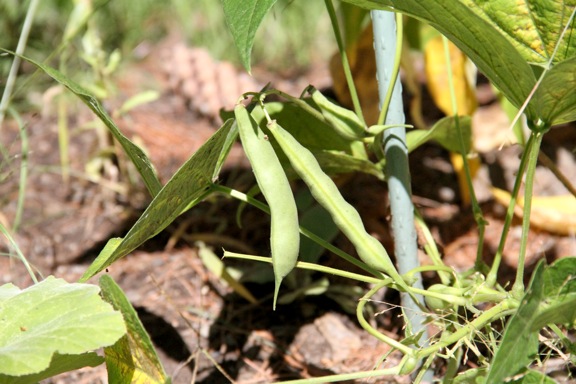SAVOR THE SEASON: New York state plays important role in U.S. bean industry

Above, snap beans grow in the Three Sisters outdoor exhibit at the Six Nations Indian Museum in Onchiota. (News photo — Andy Flynn)
LAKE PLACID – The Lake Placid News crop of the season is beans – one of the Three Sisters along with corn and squash, as the native Iroquois tribes called their life sustainers.
The Iroquois grew 13 varieties of beans: bush beans, wampum, purple kidney, marrowfat, string, cornstalk, cranberry, chestnut lima, hummingbird, white (small), wild peas, bean vines and poles.
The U.S. Department of Agriculture separates beans into two categories: dry edible and snap.
Dry edible beans
Dry beans are legumes that are grown to the mature stage, allowed to dry and harvested for the seed within the pod, according to the USDA.
The most-grown dry beans in the U.S. (2006-2008) were pinto, 42 percent; navy (pea), 17 percent; black, 11 percent; great northern, 5 percent; and garbanzo (large chickpeas), 5 percent.
Other varieties are light red kidney, dark red kidney, large lima, baby lima, pink, small red, cranberry, black-eyed (cowpeas), small chickpeas and small white. These are the ones covered by the USDA, but there are many more, such as yellow eye, fava (horse or broad beans), mung, adzuki, marrow, appaloosa, Christmas lima, Anasazi and black gram beans.
At 6 percent output, the U.S. is the sixth-leading producer of dry edible beans in the world.
In the U.S., New York state was the home of the commercial dry bean industry, although it gave away its leading role to other states as the country grew and now plays a minor role.
In 1836, a man named Stephen Coe planted a pint of small white beans on his farm near Yates in Orleans County, according to a May 27, 2016, article published by the University of Nebraska-Lincoln, “The US Dry Bean Industry Begins in New York,” written by Bob Harveson and Carlos Urrea.
“After three successive crops he had produced enough beans to sell,” the article states. “His son, Tunis H. Coe, sold a load of 33 bushels to H. V. Prentiss from Albion, N.Y. who was apparently the only man in Orleans County who could be convinced to buy that many. This is thought to be the first consignment of beans commercially sold in the U.S.”
Although beans had been grown by the Iroquois for centuries, the beans on the Coe farm were the first organized attempt to cultivate them for sale.
“This initial sale of 33 bushels in 1839 grew to more than 500,000 bushels of beans from New York by the late 1890s. Initially, New England was the sole purchaser and consumer of these beans, but by the turn of the century, new markets (both domestic and foreign) and demand had grown substantially.”
Eventually, dry bean production expanded to Canada and westward, especially after the Civil War. By the beginning of the 1900s, New York’s leading role in the dry bean industry waned, and other states took over the lead, Michigan at first and eventually North Dakota.
In 2006-2008, the top growing states for dry edible beans were North Dakota, 38 percent; Michigan, 14 percent; Nebraska, 11 percent; Minnesota, 10 percent; Idaho, 7 percent; California, 4 percent, Washington, 4 percent; and Colorado, 3 percent.
Cornell Cooperative Extension estimates that New York produces about 2 percent of the U.S. dry edible bean crop, with 60 percent being processed (canned) and 40 percent being dry packed. Major types are light and dark red kidney beans (62 percent) and black turtle soup beans (30 percent).
The main production regions in New York are Central New York (Ontario, Wayne, Yates, Onondaga, Schuyler, Seneca, Tompkins, Cayuga, Livingston and Oneida counties) and Western New York (Genesee, Monroe, Orleans, Wyoming and Erie counties).
Snap beans
Snap beans are annual, warm-season plants that are grown for young, edible, fleshy pods. They are typically called green beans and wax beans or just plain “string” beans.
In the U.S., there are three types of snap beans: bush beans, pole beans and half-runner varieties. Yet bush beans and pole beans make up the bulk of commercial snap bean production. They are sold either fresh or processed (canned or frozen).
Although snap bean production for the fresh market is led by southern states such as Florida and Georgia, plus California, snap beans are an important crop in New York, according to Cornell Cooperative Extension:
“Just under 30,000 acres are produced, primarily for processing into frozen and canned products. A small percentage of the crop moves through fresh market channels, both within and outside of the state.”
States that lead the country in snap bean production for processing include Wisconsin, Oregon and Michigan.
Cornell estimates that New York produces about 10 percent of the U.S. snap bean crop, with 84 percent being processed and 16 percent going to the fresh market.
The main production regions in New York are the Finger Lakes (Ontario, Wayne, Yates, Cayuga, Livingston and Oneida counties) and Lake Plains regions (Genesee, Orleans, Niagara and Erie counties). Other markets include eastern New York and Long Island.






